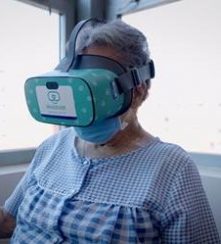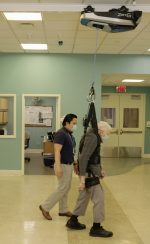RiverSpring™ Living Repurposing VR to Help Prevent Falls
July 11, 2023
Instead of thinking outside the box, Deepak Chopra taught us, get rid of the box. RiverSpring™ Living got rid of the metaphorical box when it approached Rendever about expanding on its virtual reality platform for seniors.
Founded more than 100 years ago, RiverSpring™ Living has supported the health and well-being of older New Yorkers who live in the community at large and on its Riverdale campus through managed care, home care, senior residences, rehabilitation services, and its Hebrew Home at Riverdale.
“One of the biggest issues in nursing are the falls, and fall prevention,” RiverSpring’s David V. Pomeranz told Senior Living News in a conversation about how the West Bronx-based community is using technology to enhance its resident and patient care, including using virtual reality to help prevent falls.
Pomeranz, who joined RiverSpring 38 years ago “pushing wheelchairs,” climbed the ranks one rung at a time to his current position of Chief Operating Officer. “When you learn the business and the organization from the ground up,” he said, “it gives you a lot of value to really understand and to see things from a different perspective.”
Senior Living News: Let’s talk about RiverSpring’s partnership with Rendever.

David V. Pomeranz: This is an opportunity for us to work with people in rehabilitation. Normally in rehabilitation you’re in a gym, working on different things to get strong enough to go back home. This technology was something that we suggested to [Rendever]; it allows them to send a GoPro camera home with the family, to film the actual place where the resident lives, so when they come back with the camera, and we plug it into the headset, it allows the person to do the rehabilitation as if they’re in their own home. And from a standpoint of feeling like there’s hope, feeling like there’s drive, feeling like you’re getting back home quicker, then emotionally you’re connecting back to where you want to return to. It really is a substantial opportunity for people — aside from logistically: “Your bed is here, your chair is here, you have to walk through this space” — to be able to do it from a psychological standpoint is a really motivating and comforting feeling for people.

Hopefully, it expands to more facilities … being in a hospital or nursing home or rehab center is very disorienting for people, even in great facilities; you’re 70 or 80, and it takes you off your game. To be able to use technology to really be able to connect back to where you’re comfortable, it has changed the way they look at things. They’re more willing to work harder, to push longer in their rehab.
We hope it’s something that takes off because our goal is to help people everywhere. We’re a facility that shares information, shares ideas always; that’s sort of our best-practices philosophy. Rendever’s a terrific product to use for other things: reminiscing, virtual tours of places, you can do lots of different things, but for them to shift and be able to do another [thing] with it will help everybody, so we’re pretty excited about it.
SLN: In what other ways do you utilize technology at RiverSpring?
DVP: We were lucky enough to connect with a very generous donor; her husband was very involved with technology space, and we were very involved in caring for him. Her generosity to us was this gift, which allowed us to take steps [with] technology which facilities like ours could never do. We have really changed the way that we’re able to operate … she bestowed on us a really sizeable gift, just for technology.
The first thing we did was put in a new call bell system. Call bells are the No. 1 complaint in all nursing homes and all hospitals across the world: people push the button, they feel like they wait too long. Sometimes they exaggerate it — “It took two hours”; really, it took eight minutes — but sometimes it takes too long. That’s reality. Now, in our facility we have a call bell system where when they push the bell it rings a cell phone of one of the caregivers, so they get an instant response, and the caregiver can then triage and say, “I understand you want a bottle of water or your TV’s not working right, I’ll get to you as soon as I can,” versus, “You don’t feel well, I’ll be right there.” And we get statistics on it every day, so when I have a family come to me and say, “Mom says she pushed the call bell and it took an hour for somebody to come,” I can pull up a report and say, “Actually it took two minutes and 30 seconds,” or I could say, “It took 10 minutes and here’s the reasons why.” It’s changed the way that we communicate with our residents around their needs.
The biggest wrinkle to me is we’re a unionized organization, and 1199 is a very powerful union in our state — they could squash anything — and they embrace this technology because they felt it protected their workers from being accused of things which were unfair. So, it really has been a marvelous success. Even hospitals come to look at it. It was a really big purchase, about a third of the gift we were given, but the dividends are really unbelievable in the sense that we have real-time information, and the residents have real-time responses. There’s a lot of anxiety when you push that call bell; you push it because you need it, and a minute can feel like an hour if you feel like you can’t breathe or something’s going on. That was [our] first piece of technology; we then graduated to many others.
SLN: Tell us about some of those others.
DVP: We have a system that analyzes your ambulation, to determine your likeliness to fall. It does a computerized rendering, and it matches you, like an avatar, as you walk; it gives you a score. It can determine your pace: Is your pace fast enough? Are you leaning? By analyzing people’s strength of ambulation, it helps us better work with them to prevent them from falling.

We have a robot in our gym called ZeroG. We won a McKnight’s Award for the best innovation of the year last year with this robot. Basically, the robot assists somebody to ambulate; they have a fractured hip, for example, and they have to start to walk again. It’s terrifying if you’re a senior to start walking again when you‘ve had a fall. The way it works in most nursing homes is you have to have two people holding on to you, giving you a wedgie by holding your pants in the back, while you’re walking, so you don’t fall. [With ZeroG, residents] actually go into a harness and the first thing we do is show you can’t fall, that the robot will not let you. You can take the body weight off in percentages, so they have 10%, 20%, 40% of body weight, and this allows them to walk around the gym.
SLN: Clearly technology is something that you’ve embraced. How long have you been doing the program with Rendever?
DVP: We’ve been with Rendever for probably two years; this new wrinkle is probably eight to 10 months old. I can’t tell you 100% of the people do it because some families have challenges — they can’t get to grandmother’s in Brooklyn, they live in the Bronx — but I would say we’re probably successful 60% to 70% of the time. We also offer them other things while they’re doing that: If they want to film a soccer game or Little League game from a grandchild, we’re happy to pop that in as an additional perk.
To be in your own home, and to walk to the kitchen and to walk back and feel like you’re doing it, and to be able to talk to the therapist about the things that they see in the camera, the therapist can point out things that they see, like carpets and cords and things, which are dangerous. Most people don’t think about safety risks in their own homes, but we do … we encourage people all the time to think about safety.
And to give you one more side of technology, we have a device now, you put it over your hand, and you can see the vein. Many older people have very difficult veins to find, and this pops them so you can see them perfectly. The reason I mention that is that it was suggested by one of the nurses. We’ve created a culture where ideas are not only coming from the top, or from the rehab, they’re coming from everywhere.